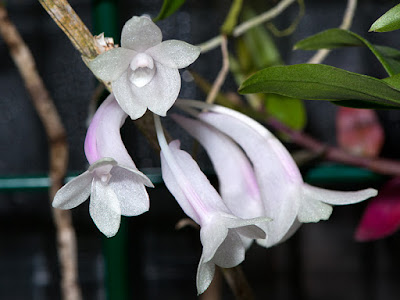Dendrobium aphanochilum is native to Molukka Islands, including Ambon and Seram. On the island of Seram, they grow in the Makino river, at an altitude of 1000-1100 m and on the Hatoemeten pass, south of Manoesel, at an altitude of 1500-1700 m. On the island of Ambon, they meet at Mt.Salhoetoe at an altitude of 800 m.
Dendrobium aphanochilum, also called as The Insignificant Lipped Dendrobium, Chromatotriccum aphanochilum, Pedilonum aphanochilum, is a species of the genus Dendrobium. This species was described by Friedrich Fritz Wilhelm Ludwig Kraenzlin in 1910.
IDENTIFY DENDROBIUM APHANOCHILUM
Dendrobium aphanochilum is native to Molukka Islands, including Ambon and Seram. On the island of Seram, they grow in the Makino river, at an altitude of 1000-1100 m and on the Hatoemeten pass, south of Manoesel, at an altitude of 1500-1700 m. On the island of Ambon, they meet at Mt.Salhoetoe at an altitude of 800 m.
It is a small to just medium sized, warm to cool growing epiphyte, which can reach 30 cm in height, with slender, cane-like, curved, up to 30 cm long pseudobulbs carrying deciduous, ovate-lanceolate, bidentate apically, 6-8 cm long leaves.
The Insignificant Lipped Dendrobium blooms in the spring and fall on a short, 5 to 9 flowered inflorescence arising from the upper nodes along a leafless cane and carrying slightly fragrant flowers. The white flowers are 4 cm in diameter. The very wide ridge petal is slightly uneven at the apex. The side petals are broadly ovoid. The oval petals of the inner whorl are variable at the apex, uneven to the hairy ones. There are lines at about 60% of the lip.
DENDROBIUM APHANOCHILUM CARE AND CULTURE
Cultural information should only be used as a guide, and should be to be adapted to suit you. Your physical location; where you grow your plants, how much time you have to devote to their care, and many other factors, will need to be taken into account. Only then can you decide on the cultural methods that best suit you and your plants.
Light:
Dendrobium aphanochilum needs a light level of 20000-30000 lux.
Temperature:
It is a thermophilic plant. The average summer temperature is 24 ° C, 17 ° C night, giving a daily difference of 7 ° C. The average temperature of the winter day is 20-22 ° C, night 16 ° C, with a daily difference of 4-5 ° C.
Humidity:
The Insignificant Lipped Dendrobium needs a humidity level of 75-80% for most of the year, and rising to 85% in winter.
Substrate, growing media and repotting:
Dendrobium aphanochilum is best mounted on tree fern rootstock, but in summer the plants must be watered at least once a day and the high humidity. You can also use hanging pots or baskets filled with loose, airy substrate. Repotting should be carried out when the roots grow actively.
Watering:
Water throughout the year is moderate to abundant, but in spring and summer it is drier. Plants in the culture can be allowed to dry slightly between watering, but the substrate should not completely dry out.
Fertilizer:
It is recommended to fertilize every week or every two weeks 1/4-1/2 doses of fertilizer for orchids. Balanced fertilizer should be used all year round.
Rest period:
In winter, the amount of water can be slightly reduced by plants cultivated in the conditions of a short, dark day. Dendrobium aphanochilum should never, however, dry up completely between waterings. Fertilization should be reduced or eliminated whenever the amount of water is limited.















COMMENTS